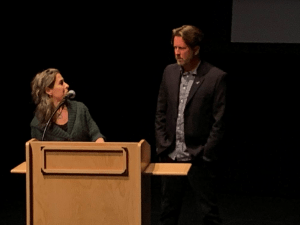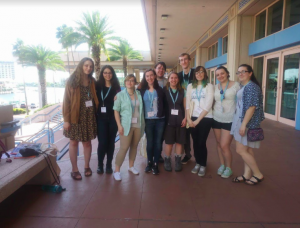
UMF Faculty Poetry Film Takes Flight
Faith Diaz Contributing Writer
Recently creative writing professors Jeffrey Thomson and Amy Neswald launched their joint project, “Blink”, a poetry film based on Thomson’s work from his new book, “Half Life: New and Selected Poems.” Thomson is currently the Creative Writing Director at UMF and works alongside Newswald, who has just secured the position of Associate Professor of Screenwriting and Creative Writing.
In September 2018, at the annual BFA staff reading, Thomson read and performed his poem, “Blink.” The poem follows a man whom has just had his head cut off. Legend suggests that the man, Antoine-Laurent de Lavoisier, suggested that his friend watch his execution and count as Lavoisier attempted to blink numerous times after the separation of the head from the body. Lavoisier wanted to see if they could record this phenomena and had hoped someone would following his death. In some way, his wish was fulfilled.
The legend found its way to Thomson, and his poem counts and describes what Thomson imagines Lavoisier saw in those seconds of death approaching, between the blinks, and after the head had been removed.
Upon seeing Thomson’s performance of this historically fascinating legend, Neswald immediately knew she wanted to utilize it in a film platform. “I was gobsmacked by it from the very first time I heard it. I approached him shortly after to ask him if he would be willing to sacrifice it to me for a short film.” Neswald said.
At the time, Neswald had just begun at UMF and was a bit hesitant, but the work dictated her need to pursue it, “Even though I didn’t know what it would look like, I knew it was a perfect piece to tell visually. It deals with what someone is seeing, as he’s dying, through these series of blinks. And [Thomson] said, ‘Yes.’ and that was that.”
Neswald’s background is in screenwriting and having spent years in the backstage of Broadway, poetry was a new avenue for her to be exploring. “One of the reasons I wanted to make a poetry film is because I am one of those horrible fiction writers who says constantly that I don’t understand poetry, I’m not a poet, and I thought this would be a really good way for me to get inside a poem and understand it from a vantage point that I could. To live inside a poem for a while. And I lived inside of it for a really long while.”
The process of figuring out what the aesthetic of the film was going to be was complicated and continuously changed. “I was aiming to make something very simple and stark,” Neswald said. “Originally I wanted to do a muslin background with a moving black thread [that would] kind of like sew different panels in a stop motion way.”
Neswald soon realized that the images weren’t coming out the way she intended so, she switched her tactic and stumbled upon an aesthetic she loved, based on the image of the text that stuck with her most. “Thinking about one section of the poem that’s really visual about clovers in a field and in looking at pictures of clovers and fields in France, I stumbled on an aesthetic that was far from my personal aesthetic. Which was super frightening but also kind of exciting.”
Neswald believes that even if a project is frightening, that one should pursue it anyway. This was a guiding philosophy that helped her keep up the motivation for this project.
“I built my pictures, my layers in photoshop, my puppets, decided what the moving parts would be and how to compose them,” Neswald said. “It was a collection of images from mostly the internet that I adjusted deeply and greatly that I used as a collage to create the scenery and puppets.”
Eventually, the project came together. “When I start a project, I am always a beginner because each project wants to be told in a different way, so, to be an absolute beginner and I have never made a poetry film, and I’ve animated before but I have never animated in this way,” Neswald said.
“And I’ve never worked on someone else’s work in a collaboration in this format and then to be working with someone who is kind of a big deal, I stepped outside of my comfort zone quite a lot on this project.”
In October of this year, Neswald flew to Cork, Ireland, where her film was Shortlisted for O’Bheal Award.
